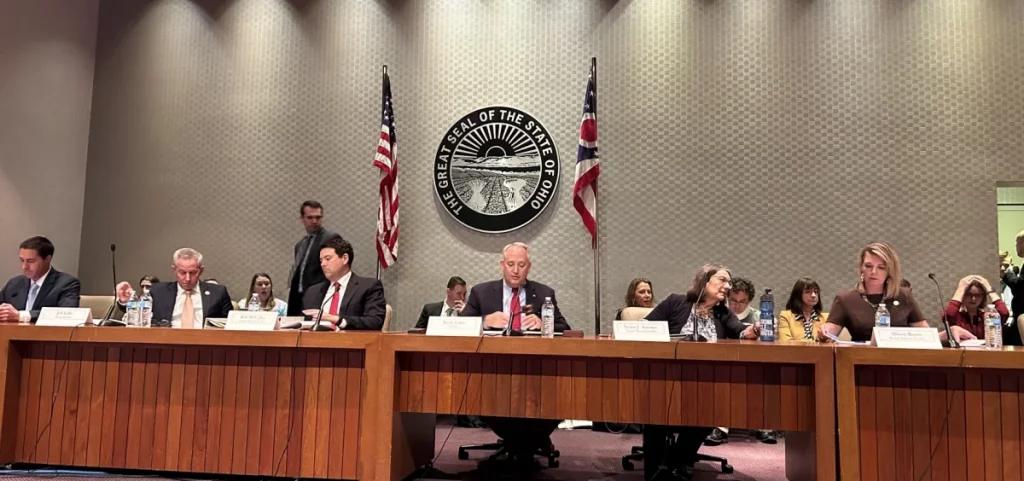News
Why did Democrats on the Ohio Redistricting Commission vote for maps they said were unfair?
By: Jo Ingles | Statehouse News Bureau
Posted on:
COLUMBUS, Ohio (Statehouse News Bureau) — The Ohio Redistricting Commission unanimously approved new state legislative district maps late Tuesday night.
The two Democrats on the panel railed against the map-drawing process, but in the end they voted for the maps. And because the vote was unanimous, the maps will be in place for eight years.
Many have questioned why Democrats voted for the maps that they said gave Republicans an unfair advantage. Senate Minority leader Nickie Antonio (D-Lakewood) said the map she and
House Minority Leader Allison Russo (D-Upper Arlington) approved was better than the one the commission started with.
“It was a compromise. Many things came to the middle. So considering that, I believe that we are in a better place, we have positioned Ohio to have more competitive elections this next cycle, that there will be more competitive districts because of what we did and that the people of Ohio will have a better opportunity for representation than they do today,” Antonio said.
Antonio and Russo introduced working maps of their own at the first meeting of the commission, but those were rejected by the five other members of the panel, all Republicans.
In the end, the map that was voted out of committee will likely give Republicans a 61-38 advantage in the House and a 23-10 advantage in the Senate. Right now, Democrats have seven of 33 seats in the Senate, and 32 of 99 seats in the House.
Antonio said she voted for the maps she admits she didn’t like because they allow for more competitive districts than under other scenarios.
“My focus was getting the best work product that would serve the people of the state of Ohio,” Antonio said.

The Democrats on the Redistricting Commission want voters to change the process
Both Antonio and Russo said the current redistricting system is broken and called on Ohio voters to take the process away from politicians and put it with a citizens commission. An amendment that would do just that is being reviewed by the attorney general before supporters can gather signatures to put it on the November 2024 ballot.
The League of Women Voters of Ohio is one of the groups trying to put that redistricting reform measure on the ballot. Executive Director Jen Miller said it’s obvious the current process is flawed.
“The maps are not fair. … They were drawn behind closed doors where no one was able to testify on them and the substance of them. They divide communities that should otherwise be held together because they’re so similar socially and culturally and economically,” Miller said.
Under the current process, Miller said politicians from both parties decided the most important thing was to get their friends re-elected.
Catherine Turcer, executive director of Common Cause Ohio, is also working to put a new redistricting process before voters next year that uses an independent panel of citizens to draw maps.
“We are working together on an amendment to ban politicians from map drawing so that Ohio voters get the impartial districts they fundamentally deserve, and lawmakers will be responsive to the people rather than mega-donors and lobbyists,” Turcer said.
The former chief justice of the Ohio Supreme Court, Maureen O’Connor, was part of the court that struck down former legislative redistricting maps five times.
The map currently being used was allowed under a federal court ruling that stipulated new maps be in place for 2024. O’Connor said the way to have faith in the redistricting process is to put Ohioans, not politicians, in charge of the process.
“From waiting more than a year to get to work, to holding hearings in remote locations at times when working people are earning their living and can’t participate, to voting for their own political interests, we have seen once again, that politicians —Democrats and Republicans both —can’t be trusted to draw fair maps in an open and transparent process,” O’Connor said.
But Senate President Matt Huffman (R-Lima), who is not on the redistricting commission, defended keeping politicians in charge of the redistricting process.
“We have a definition of politician that some people put over there and say, ‘That’s the worst person in the world.’ And then we have another definition of these are the people who step forward to make decisions and on behalf of the public. So when people say politicians, I say elected officials and people say, ‘Well, elected officials shouldn’t do that, unelected people should do that.’ And that is not representative democracy. That’s not what our constitution says,” Huffman said.
There’s no word on whether there will be a lawsuit over the new maps though there has been a pattern in the past that litigation follows.

